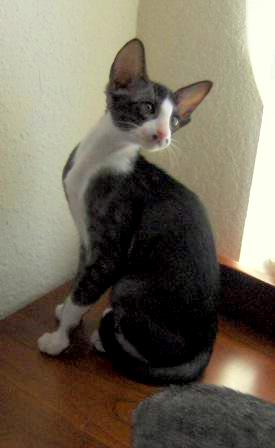Oriental bicolour facts for kids
| Oriental bicolour |
|---|
 |
| Country of origin |
| United States |
| Breed standards (external links) |
| GCCF |
An Oriental bicolour is a special kind of cat. It has a sleek, athletic body, similar to an Oriental Shorthair. What makes it unique is its beautiful coat, which has patches of white. These white spots are caused by a special gene called the white spotting gene. These cats can have either short or long hair. They come in many patterns, including colourpoint, which means they have darker fur on their ears, face, paws, and tail.
Most cat clubs see Oriental bicolours as a color variation of other breeds, like the Oriental Shorthair. But in the United Kingdom, one big cat organization, the Governing Council of the Cat Fancy (GCCF), calls them a separate breed named Oriental Bicolour.
Contents
History of the Oriental Bicolour
Although some early breeding happened in the United Kingdom during the 1970s and 1980s, the modern Oriental bicolour cats mostly started in the United States. A breeder named Lindajean Grillo began her work in 1979.
How the Breed Started
Lindajean Grillo started by mating Siamese cats with bicoloured American Shorthair cats. She then chose the best bicoloured kittens from these litters. These kittens were then bred back to Siamese or Oriental cats. This helped to get the desired body shape and look. The variety was officially recognized by TICA in 1983. The first champion cat of this type was named Ciara Quite-N-Oreo.
European Development
During the 1980s, breeders in Europe, especially in France and the Netherlands, also started their own Oriental bicolour breeding programs. They used a red and white street cat from Morocco as a starting point. Later, a Black & White Cornish Rex was also used. More cats were brought in from the USA. It was important for breeders to have different cat families. This allowed them to breed bicolour cats together and get more white on the coats, without too much inbreeding.
Official Recognition
The FIFe cat organization gave official recognition to bicoloured Oriental Shorthairs in 2003. In 2005, they also recognized the colourpoint and white cats under the breed name Seychellois.
In the UK, the first modern Oriental bicolours arrived in 2004. The variety gained official recognition with the GCCF in 2006. By 2008, the breed quickly moved to Provisional Status. This was the fastest recognition for a breed in this organization. It showed how popular and successful the breed had become.
How Oriental Bicolours Are Registered
Different cat organizations have different rules for registering Oriental bicolours. Some groups register bicoloured Oriental Shorthairs and bicoloured Siamese/Seychellois separately. This keeps the genetic lines for long or short coats, and for colourpoint or solid patterns, apart. This can make it seem like there are many different types of Oriental bicolours.
The GCCF has a different approach. They treat bicolours as one breed, called Oriental Bicolour. They allow all these related groups to be bred together. This means cats carrying genes for colourpointed long hair are still considered part of the breed. Cats like Siamese, Balinese, Oriental Shorthair, and Oriental Longhair can be bred with Oriental Bicolours. All the kittens from these pairings are registered as Oriental Bicolours. Kittens who don't get the white spotting can now be registered as Orientals in the GCCF. They can also be shown in cat shows.
Appearance of the Oriental Bicolour
Oriental bicolours are cats with a modern Oriental look. They have a long, thin body and a tail that tapers like a whip. Their head is shaped like a triangle with straight lines. They have a straight profile and large ears set wide apart.
Eye and Coat Features
Most Oriental bicolours have green eyes. However, the colourpoint varieties have beautiful blue eyes. The short-haired cats have a sleek, shiny coat that lies close to their body. The long-haired cats have fine, silky fur that also lies flat. They don't have a thick undercoat. Their tail forms a lovely plume.
Colors and Patterns
These cats can come in all the colors seen in Siamese and Oriental cats. But the most important feature is their white spotting. For a cat to be considered show quality, at least one third of its body should be white. The white patches can be random, almost like splashed paint. There is always more white on the cat's belly and legs compared to its back. This unique pattern is caused by a dominant gene called the white spotting gene, which is shown by the letter S.

